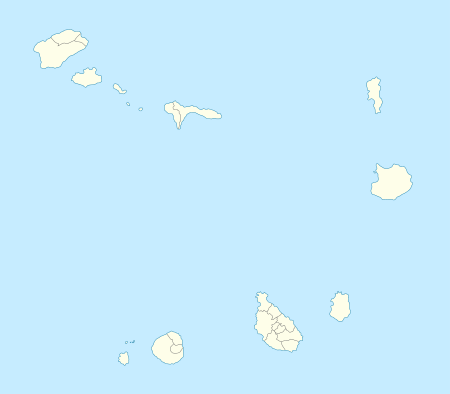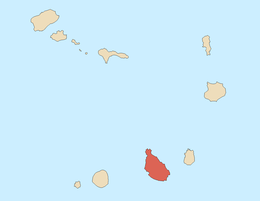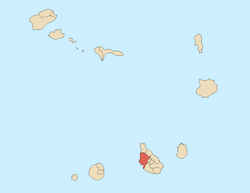Assomada
| Assomada | |
|---|---|
|
The summit city | |
 | |
| Coordinates: 15°05′46″N 23°40′01″W / 15.096°N 23.667°WCoordinates: 15°05′46″N 23°40′01″W / 15.096°N 23.667°W | |
| Country | Cape Verde |
| Island | Santiago |
| Municipality | Santa Catarina |
| Civil parish | Santa Catarina |
| Population (2010)[1] | |
| • Total | 12,332 |
Assomada (in Cape Verdean Creole: Somada) is a city on the Sotavento (leeward) island of Santiago in Cape Verde. It is the seat of the municipality of Santa Catarina, which comprises the central western part and much of the interior of the island, and it is the largest city in that region. Assomada lies at about 550 m elevation on a plateau surrounded by mountains, farmland, and hills in the center of Santa Catarina. Surrounding communities bordering Assomada includes Gil Bispo to the northeast, Palha Carga to the west and Boa Entrada to the north.
Assomada lies at approximately the midpoint on the highway that runs the length of the island of Santiago from Praia (the capital) in the south to the seaside port of Tarrafal in the north. It is also connected by road to the eastern port of Pedra Badejo. Assomada is located 26 km northwest of Praia.
The etymology of the name is a portuguese word, the other word assomar (to loom) and assomar-se (looming) indicates that a city is in a highest portion of an island, in an area of the highest part of a plateau on the island. It is the etymology of the other two Assomadas, one in the Azores and the other in the Madeira Islands.
Geography
Assomada has an urban area of about 550 ha or 5.5 km².
In 2015, it has about 15,000 people throughout the city and is the second largest on the island. The city has grown considerably since the independence of Cape Verde, and the regional center attracts many people coming from the interior and other parts of the island in search for work.
Assomada plays an important commercial role and has a pleasant combination of urban areas and fields. The city centre features many Portuguese-style colonial buildings.
In 2005, its urban area was 213 ha or 2.13 km².
.jpg)

Subdivisions
Assomada is subdivided into 22 neighborhoods including Achada Riba, Atrás de Banco, Bolanha, the City Center (central part), Chã de Santos, Covão, Covão Ribeiro, Cruz Vermelha, Cumbém (located in the south), Cutelo, Cutelo Torre, Espinho Branco, Leiria, Lém Vieira, Matinho, Nhagar (located in the north), Pedra Barro, Ponta Fonte Lima, Portãozinho, Tarafalinho and Tras da Empa (Traz d'Empa).
History
In 1833, colonial governor Manuel António Martins tried to move the seat of Santa Catarina from Ribeira Grande in the south to nearby Picos.[2] Ribeira Grande would later become part of the municipality of Praia, Ribeira Grande is now part of its own municipality.
On May 4, 1912, the seat of the municipality moved from Tarrafal to Assomada and became the municipality of Santa Catarina by the colonial governor Joaquim Pedro Vieira Júdice Biker[3] The northern portion split and became its own municipality of Tarrafal.
Santa Rita Vieira relates on different places which acted as the municipal (county) seat including Ribeira da Barca in 1845, Casa Grande south of Assomada near Picos between 1845 and between 1851 and 1857, Flamengos near Saltos de Cima between 1846 to 1849, Achada Falcão (in Cabeça Carreira) in 1859 and Mangue in Tarrafal in 1869.
A series of demonstrations and rebellions took place in the colonial years, the latter being the struggle for Cape Verdean independence took place in Assomada, one was in 1822, then the Fonteana Revolt in 1835, the Ribeirão Manuel Rebellion in 1910, a petition in 1946, demonstrations over the elevation of the Minister of the Overseas in August 1962 and the student's battle in Spring 1970.[3]
On May 13, 2001, Assomada was elevated to a city. The document related to an elevation was made on March 26, the text of the decree was related to that of Júdice Biker who created the municipality of Santa Catarina. The bill went into parliament, it was approved by the Minister of Councils by José Maria Pereira Neves, Carlos Duarte de Burgo and Maria Cristina Fontes Lima.[3]
Demography
.jpg)
Though the Portuguese and mullattos made up the majority of residents at least until the 1990s, today (2015), Assomada is increasingly becoming cosmopolitan with a diverse population. Thousands of immigrants (i.e., black Africans, Chinese, Portuguese, and other nationalities) live and work in the city.
| Historical population | ||
|---|---|---|
| Year | Pop. | ±% |
| 1990 | 3,414 | — |
| 2000 | 7,067 | +107.0% |
| 2005 | 11,900 | +68.4% |
| 2010 | 12,332 | +3.6% |
| 2015 | 15,000 | +21.6% |
| Source: [4] | ||
Other data
The other data of the 2010 population including male and female were:
| Sex | Residential population | Age | ||
| Under 15 | Between 15 and 64 | 65 and over | ||
| Total | 12332 | 3760 | 7965 | 605 |
| Male | 5900 | 1814 | 3850 | 234 |
| Female | 6432 | 1946 | 4115 | 371 |
Landmarks and other features
The market of Assomada, founded in 1931 is one of the largest on the island of Santiago, with a large variety of agricultural products and crafts. It is the central collection and distribution point for products produced throughout the surrounding countryside, and while the consumer-focused market is very large and vibrant, the majority of the trade is between middlemen (rabidantis) who bring the produce to larger national and international markets.
Assomada is also home to one of Cape Verde's few museums: the Museu da Tabanka, which sits outside the city square. The building was built by the Repartição da Fazenda e dos Correios, and is considered a cultural and historic heritage site for its architectural origins. It doubles as the Assomada Cultural Centre when hosting parades, traditional concerts, and other cultural events. The Museu da tabanca organizes temporary exhibits, adding to cultural life in Santa Catarina and the interior of the island of Santiago. The museum also features a valuable collection of local writing and paintings. Located in the middle of the city is the Norberto Tavares Cultural Center (CCNT - Centro Cultural Norberto Tavares), named after a composer.,[5] also it has its cinema, the Cineclube.


Education
In addition to a professional school (i.e., Escolha de Formação Profissional), Assomada has two universities (i.e., Instituto Universitário de Educação and Universidade de Santiago), an extensive school complex, including a public "Liceu" (Amilcar Cabral High School), two private secondary schools (Centro de Ensino de Assomada and Escola Secundária Abrolhos) and a "Escola Primária" (primary school). It is also the home of the elite vocational school (i.e., technical school Grand Duke Henri), which trains the most promising Cape Verdean youth in career skills.
Economy
Commerce, financial services (particularly banking), transport, and educational services are the lifeblood of the city. Among the entities that contribute much to the local economy are: six commercial banks, hundreds of retail and wholesale businesses, a relatively large fleet of taxis and minivans, schools (including private secondary schools and a private university). The "summit city" as it is kindly called by its locals and the outsiders is increasingly consolidating its economic success and self-sustainability. The residents of the city of Assomada enjoy the highest living standards on the island of Santiago.
Sports
Assomada is the center and is home to the headquarters of the North Zone of the Santiago Island League. Football (soccer) clubs includes Desportivo de Assomada, Os Amigos, Juventude de Assomada and Associação Juventus. Clubs based in a neighborhood includes Inter which is based in Cutelo and Grémio Desportivo which is based in Nhagar. All clubs based in Assomada and the municipality play at Estádio de Cumbém. Assomada also has basketball, volleyball and futsal clubs.
Notable people
- Orlanda Amarílis, writer
- Victor Borges (or Victor Barbosa), Minister of Foreign Affairs from 2004 to 2008
- José Maria Neves, Prime Minister of Cape Verde between 1991 and 2016
- Gilyto Semedo, singer
- Henrique Lubrano de Santa Rita Vieira[6] (1912-2001), doctor
- Gustavo Monteiro, politician
- Fernando dos Reis Tavares (Toco), militant for the liberation of Cape Verde
References
- ↑ "2010 Census results". Instituto Nacional de Estatística Cabo Verde (in Portuguese). 17 March 2014.
- ↑ Vieira, Henrique Lubrano de Santa Rita (1993). A Vila de Assomada. Associação dos Amigos do Concelho de Santa Catarina. p. 14.
- 1 2 3 Vieira, Henrique Lubrano de Santa Rita (1993). A Vila de Assomada. Associação dos Amigos do Concelho de Santa Catarina.
- ↑ Source: City Population, citing the Instituto Nacional de Estatísticas.
- ↑ "Assomada: Vida e obra de Norberto Tavares em debate". Expresso das Ilhas (in Portuguese). 22 December 2011.
- ↑ Henrique Lubrano de Santa Rita Vieira - Antepassados e parentes de Jorge e Garda Brito
Further reading
- Mário Fonseca, Assomada nocturna, Manuel Veiga, Literature of the Islands of Cape Verde, Karthala, Paris, 1997, p. 225-230 ISBN 9782865377978
- Nicolas Quint, Assomada, in Les îles du Cap-Vert aujourd'hui : perdues dans l'immensité, L'Harmattan, Paris, Montreal, 1997, p. 30-31 ISBN 2-7384-5773-8
- Henrique Lubrano de Santa Rita Vieira, A vila de Assomada, Associação dos Amigos do Concelho de Santa Catarina, Santa Catarina, 1993, 70 pages
External links
| Wikimedia Commons has media related to Assomada. |


